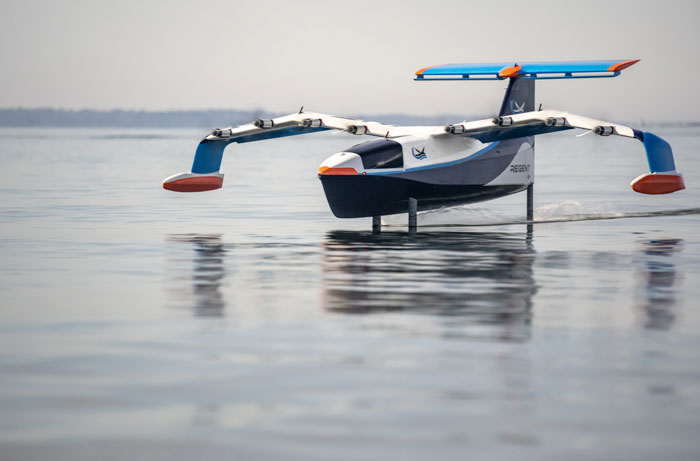

Aviation buffs and better read naval architects will already be up to speed about the Soviet Ekranoplan ground effect craft programme which ran from the early 1950s to the late 1970s. Out of that programme emerged the famed Caspian Sea Monster which had military analysts around the world scratching their heads. Now the same ground effect flight concept is back in modern guise and with the benefit of today’s materials and design tools to a completely different new level of refinement, delivered through ambitious design allied with the best composite engineering and build craftsmanship. Carol Cronin paid a visit to a well-known maritime town and the famous boatbuilding family who still call it home
There’s a long-standing tradition in Bristol, RI, of building both boats and their high-tech equipment right—and right at the leading edge of technology. Today, the Moore Brothers Company is carrying that heritage forward by creating bespoke composites, all built on site by a handpicked staff from the highest echelons of grand prix sailing that’s more than doubled in number since 2020.
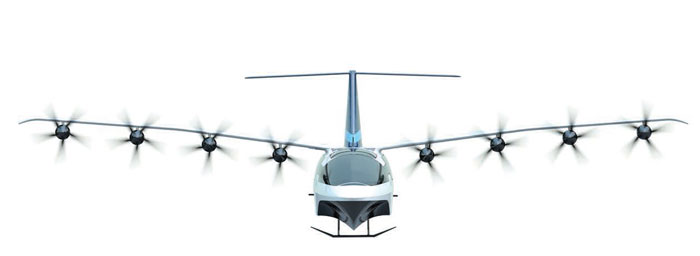
‘The business that used to be just two brothers and a couple of workers now employs 25 people,’ Oliver Moore explains, when he finally sits down at a desk completely hidden under several layers of line drawings. ‘We currently have 18 composite technicians on the floor. To meet Regent’s production goals and maintain our own business growth we need to be up to around 25 in the next year.’
You can imagine in the Seahorse office we see a lot of “cutting edge” projects – but REGENT (Regional Electric Ground Effect Nautical Transportation to be precise) stopped us in our tracks.
Building boats that fly
Regent builds all-electric seagliders, a new category of maritime vehicle designed to operate exclusively over water for highspeed coastal transportation. Seagliders operate in three modes: float, hydrofoil and flight in ground effect, moving passengers and goods from one coastal destination to another. In the spring of 2021 the company commissioned Moore Brothers to build their quarter scale technical demonstrator vehicle. The remote-controlled prototype was launched in December 2021.
‘It was the first whole vehicle we’d ever built,’ Moore says, adding that the size was a Goldilocks-style compromise between being small enough to incorporate commercially available components and large enough to be a valid testbed. ‘That's how they ended up with an 18-foot wingspan for their technology demonstrator. That dimension is critical because as a WIG (Wing in Ground effect) vehicle it flies within a wingspan above the surface of the water’.
Regent already has a $7B backlog of orders for their full-sized models. Their models include a 12-passenger and two crew seaglider called the Viceroy with a 65-foot wingspan and a next generation 50+ passenger seaglider named Monarch. These have ranges of up to 160 nautical miles using current battery technology. That’s a major upgrade in transportation efficiency, whether it’s along a crowded coastline or for island-hopping.
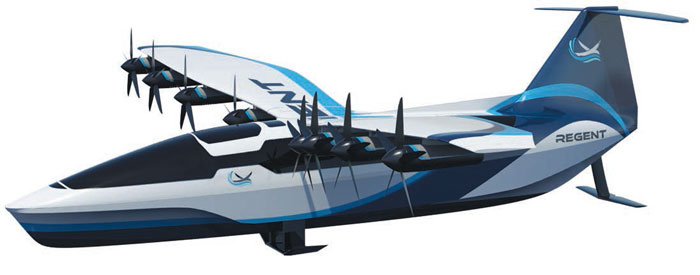
Oliver Moore introduces key team members on the project: ‘Bryan Baker and Andrew Gaynor both came straight out of the America’s Cup world. Bryan is the chief engineer of vehicle performance and Andrew is the structures lead.
‘Bryan was with Oracle and then Team Ineos in the last cup. He is one of the few people in the world who has designed both electric aircraft and high-performance racing yachts. He did a stint at Aurora Flight Sciences which is where he connected with a handful of the Regent team, so he is a cross-over link between the America’s Cup and aerospace worlds.
‘Andrew was with Oracle for several cup cycles where he connected with Bryan and then was lead rig designer for American Magic in the last cup. Andrew and I have sailed A-class and C-class cats together for 12 years and we worked together during the last American Magic build.’
Bryan Baker takes up the story: ‘Recent advances in America's Cup hydrofoiling have been critical for Regent. The company is developing a fully electric Wing-in-Ground-Effect (WIG) vehicle, coined the seaglider. Limited only by today's battery technology, Regent aims to develop a vehicle capable of reaching 180mph on the aero-wing. To achieve this performance we have to develop a streamlined hull and reduce our take-off drag. Most float planes achieve take-off by generating speed on a planing hull form which produces significant drag. The planing hull form requires relatively flat water and significant thrust to achieve take-off speed.
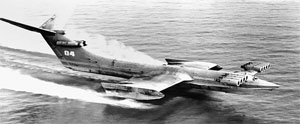
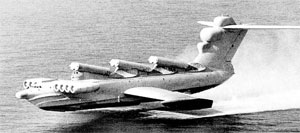
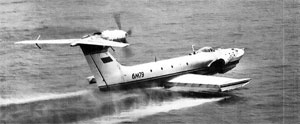
‘At Regent we aim to reduce this thrust demand by incorporating three modes of operation: from the hull (float) to the hydrofoils (foil) to the aero-wing (flight). This transition affords us a two-stage drag reduction. The vehicle first reduces wetted area from the hull clearing the water and further reduces all hydro drag as it takes off onto the aero wing. This transition directly impacts our power demands keeping us in a favourable range and weight for current battery technology. Akin to the take-off of an AC75, we concentrate on reducing hull drag via length-to-beam ratio keeping our hull form at a low Froude number. Our front foil positioned closest to our centre of gravity provides the majority of our hydrodynamic lift.
‘We control this lift by actuating symmetric flaperons on the foils which provide lift and, if articulated at different angles, can control roll. In the most recent America's Cup, several concepts were attempted to add flaps to the hydrofoils. The hinge position, stiffness of the foils, fairness of joints or skins and hydraulic actuation all played a pivotal role in drag reduction, avoiding cavitation at higher speeds and aiding controllability. At Regent, these lessons learned are critical in developing a safe and reliable hydrofoil system. On landing, we rely on the hull to provide our deceleration as the foils will be retracted into the hull body. Again, lessons learned from retraction systems developed on the AC50 provide guidance in reducing mass and delivering a reliable retraction system.’
Aero and hydro: two mindsets
Baker and Gaynor bring maritime experience to an impressively experienced and talented team of aerospace engineers. Founders Billy Thalheimer and Mike Klinker are both MIT graduates who worked with chief engineer Dan Cottrell at Aurora Flight Sciences, a research subsidiary of Boeing.
‘The meshing of the aerospace and AC engineers has been really interesting to watch,’ Moore says. ‘In the marine world we are very comfortable iterating designs with real world testing. We stopped putting test pilots up in experimental aircraft to see what would happen a long time ago and for very good reasons. As a result the marine engineers have a deep pool of real-world experience to draw upon but the aircraft engineers have an exceptionally diligent design process of validating their models and simulations to make sure that chances of failure are within very clearly defined acceptable ranges. It was impressive to watch the two mentalities mesh and the result was a very quickly executed vehicle that has been very successful in its mission so far.’ The collaboration has created a system that is agile with strong checks and balances that ensure both safety and repeatability.
It’s a boat, not a plane
Ground effect aeroplanes have been around for a long time but Moore notes that Regent is combining new technology with a fresh approach. ‘Flight control systems have been developing so rapidly in the last few decades. We’ve all seen it in the drones we buy for our kids. You're not actually flying the craft, the computer is, and you are telling it which way to go. The electric propulsion also adds an interesting element. It allows you to use many small propellers instead of a few big ones. This distributes the flow from the thrust evenly over the wing creating a blown wing effect like apparent wind in sailboats giving more lift earlier and allowing for slower take off speeds.’
Given that Regent’s design is a WIG that lands on her hull, she is technically a boat and therefore governed by the US Coast Guard. This leads to fewer regulatory hurdles than the electric planes other companies are developing. ‘The FAA requires you to carry 30 minutes reserve fuel in the daytime and 45 at night, so you can always make it to an airport, which, when we are talking about short distance flights and batteries, is a major weight penalty. Because this is a boat and it can always land on the water, the Coast Guard doesn’t have those requirements.’
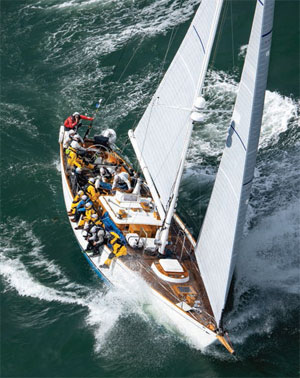
Hound: Improving a classic
When the owner of Hound, a 59ft Aage Nielsen sloop built by Abeking & Rasmussen in 1970, came to Moore Bros for a new carbon mast less than a year before the 2022 Bermuda Race, no one expected what Oliver Moore calls “a pretty cool classic boat” to win her class – thanks in part to the composite bowsprit, rudder, rig and boom that were soon added to the original order.
The mast was designed, built and stepped in less than six months, giving the crew enough time for extensive sea trials before the race. And that new bowsprit supported the A-sails so critical to a Bermuda victory. ‘We worked from 3D scans of the whole boat and designed a centreline sprit that fit in with her lines,’ Moore says. ‘The bowsprit splits around the forestay and two tack lines run aft.’
One reason for the success was that Moore Bros were included in the in-depth discussions about the owner’s overall goals from the very start of the project. ‘He wanted to breathe new life into the boat and revitalise her,’ Sam Moore says before adding with a chuckle: ‘we got a call from the boat captain after the race, saying that the boat felt completely different; “now she just keeps surging!” That means she’s actually going forward, not just tipping over.’
The owner was so pleased, he’s also ordered a cruising sprit with a bow roller to hold an anchor. ‘We had templates based on the 3D scans for the racing bowsprit, but we needed to go “real world” on this one,’ Oliver Moore says. ‘We had to go down to the boat to figure out how to make the anchor fit into such a tight space.’ Yet another example of the Moore Brothers get-it-done attitude, which has helped increase both their work force and name-recognition so dramatically in the past two years.
There are plenty of wild ideas on the leading edge of any industry, Moore admits, but he believes Regent has a great shot at success. ‘The seaglider is differentiated. It uses existing technology and has demonstrated customer demand – it makes sense.’ Design for the first full-sized seaglider is well under way and the build is scheduled for 2023. Regent is tracking to a 2025 vehicle delivery.
And of course, sailing’s top engineers always enjoy being stretched. As Baker says: ‘This project is a ton of fun. Working with Moore Brothers has been crucial in the rapid development of our 18ft technology demonstrator. In nine months we went from blank sheet to the vehicle hitting 38kts foiling. We are leveraging both aerospace and maritime knowhow to push electric propulsion technologies. I've been fortunate to work with super-talented people in both these worlds in the AC and on eVTOL projects (eVTOL - Electric Vertical Take-off and Landing Plane). The seaglider is a supercool marriage of these technologies.
Making it happen
Regent originally sought out Moore Bros for their composite expertise, but they’ve also come to appreciate the company’s get-it-done attitude. ‘When they started with us,’ Moore says, ‘they had the general concept reasonably sorted but it was a blank sheet of paper on how we were going to build it. We dived in and helped them design around available materials and with processes that matched our capabilities. It was an ambitious undertaking but we developed a very strong working relationship to the point that their lead engineer had his own office in our building. Once we had the parts built we transitioned into helping to support their integration testing operations. It didn’t matter what the problem was. Brake lines on the trailer? We’ve got a local trailer guy. Space on the waterfront for testing? We connected them with Halsey Herreshoff and got them up and running here in Bristol. In our world we are used to the idea that there is a date for the first race and it is going to happen whether you are there or not. Schedule creep isn’t an option and we brought that same mindset to the Regent build. They figured out early on that we were going to do whatever it took, so now they lean on us for a lot. It's been a big challenge but also a really fun partnership.
As Regent is designing the full-scale vehicle, Moore Brothers built a full-sized test wing that has working flaps and is covered with pressure sensors to validate their CFD work. ‘It's a constant R&D project,’ says Jacques Swart, head of sales for Moore Brothers. ‘As soon as Regent comes up with something new, we get it built so they can continue with their testing. The synergy with the team to provide what they need, within their time frame is pretty big.’
Picking up personnel
In order to keep up with the Regent project while also maintaining their regular workflow, Moore Brothers are actively recruiting. ‘We need to hire several more floor techs,’ Moore says. ‘The people we've picked up already have some serious experience. Kenny Madeiro brought a crew to us from Hall Spars and the guys we've had with us forever, like Jeff Kent and Mark Raymond are still here. We've been working very hard to organically build a strong and dedicated crew, and we've put a major focus on a supportive work environment – because in the bespoke composite world, a manufacturer is only as good as the guys on the floor. It doesn’t matter how many machines or fancy tools you have; when you’re building custom composites, you can't robot your way out of a problem, you need to have some creative problem solvers in your team.’
Finding the right personnel has been their biggest challenge, Swart admits. ‘We’re always very selective because synergy is so important. If the right person comes along, we’ll find a spot for them. That’s going to pay off in the long run’.
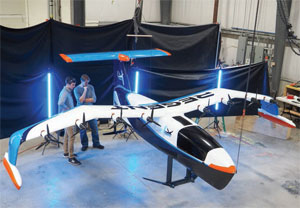
One stop composite shop
In addition to building boats that fly, Moore Brothers have become New England’s go-to place for all things foiling. ‘We’re working on a new foiling motorboat,’ Swart says, though he can’t disclose any details. ‘There’s a surge of R&D right now, all kinds of weird stuff and we’ve been involved right from the beginning.’
The reason? Swart credits their unique approach. ‘We have a group of engineers that are composite experts, but they also have an entrepreneurial, can-do attitude. So people start coming here not just to have the work done, but to get input into how to improve on what they had in mind. We’re sometimes finalising engineering details right on the floor. That draws people, because it turns a company like this into a composite solutions shop.’
That applies to non-foiling parts as well. ‘Structural composites; that's where I see people starting to catch on. Someone comes to us for a wheel, but they also need a rudder or a mast.

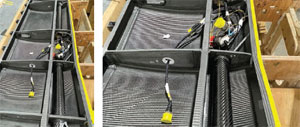
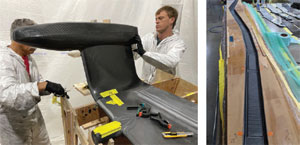
‘As we develop a relationship, they realise that we have a lot broader scope than they first thought. Everyone knows our name now, but they don’t always understand how much we can do.’
Masts, repairs and production parts too
When Hall Spars closed their Bristol facility five years ago, it left a big hole in the region’s marine industry supply chain. Moore says that “everyone and their mother” told them not to become a spar manufacturing company, but it was hard to ignore such a gaping need. ‘So the way we let ourselves get into it was this: we're not a mast company, we’re a composite company that can build you a mast if that’s what you need. We don't want to try and compete at every price point; we’ll only take on projects if we think we can do a great job.’
Alongside the Regent project, Moore Brothers are now shipping out pretty much anything that can be built out of composite—rudders, foils, beams, and yes, even masts—to boats and businesses around the world. ‘There are not many companies that can do that,’ Moore says, with justified satisfaction. They build many of Brooklin Boat Yard’s prepreg carbon parts, he adds, pointing to one of the many line drawings covering his desk; specs for a new rudder that will undoubtedly improve the performance and feel of another classic sailing boat.
‘Oliver gets super-excited about each project,’ Swart adds, ‘because he’s personally invested. And that's intoxicating. Especially since we are going to continue to bring more people in and grow manufacturing here in Rhode Island.’ By constantly breaking new ground with bespoke composites, Moore Brothers are continuing a long and successful Bristol tradition: building cool stuff right on the leading edge of technology.
Click here for more information on Moore Brothers »
We invite you to read on and find out for yourself why Seahorse is the most highly-rated source in the world for anyone who is serious about their racing.
To read on simply SIGN up NOW
Take advantage of our very best subscription offer or order a single copy of this issue of Seahorse.
Online at:
www.seahorse.co.uk/shop and use the code TECH20
Or for iPad simply download the Seahorse App at the iTunes store


